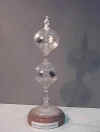
 SM174
Crookes’ Radiometer circa
1950 Heat
SM174
Crookes’ Radiometer circa
1950 Heat
Crookes discovered a highly remarkable class of phenomena that are due
to the radiant action of heated and luminous bodies.
To demonstrate these phenomena he devised an instrument called a
radiometer.
A bulb blown out of a glass tube has a fine steel point inside which has
a small vane consisting of four arms of aluminum wire with a bearing in
the centre and with each end holding a mica lozenge or disc.
One side of the mica is blackened using lampblack.
The whole vane is very light (about 2 grams).
The glass envelope is evacuated by means of a pump to a
controlled degree.
Experiments with the degree of evacuation show that if radiation is
directed at the apparatus the vane will rotate so that the blackened
side moves towards the light until a certain degree of rarefaction is
exceeded. At this
stage, the direction of rotation reverses so that the blackened face now
moves away from the radiation source.
If the bulb were to be evacuated to a very high degree, the
rotation will cease.
The explanation of the phenomena is that they are due to convection
currents in the rarefied gas.
The heat falling on the blackened surface increases its
temperature and this in turn heats the adjacent gas, reducing its
pressure and causing the movement towards this lower pressure.
The opposite rotation with higher evacuation can be explained by
the rapid movements of the gas molecules on the high temperature side
pushing the vane when they rebound from the side of the vessel.
This only occurs when the molecules are very free to move, that
is with the gas in a highly rarefied condition.
No movement would be detected in a complete vacuum.

![]()
 Museum
Museum
![]()
 SM174
Crookes’ Radiometer circa
1950 Heat
SM174
Crookes’ Radiometer circa
1950 Heat![]()